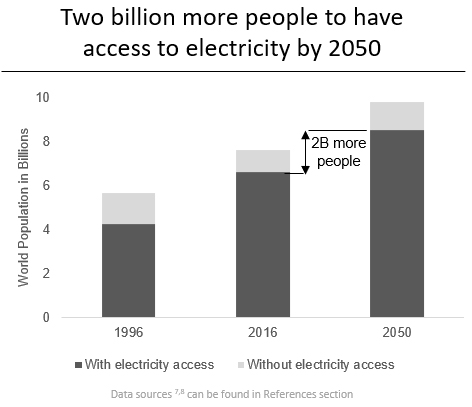Energy IQ: Consuming Twice As Much Electricity: Can We Do It Sustainably?
Increasing population, improved access to electricity and growing electricity demand in buildings will continue to increase the world’s electricity consumption.
By Aytek Yuksel, Content Marketing Leader - Power Systems

Did You Know: The world will consume twice as much electricity by 2050 1.
No, you didn't misread the previous sentence. This eye-opening stat, however, is nothing new to those who monitor trends in electricity consumption. The world's electricity production has already doubled between 1990 and 2015. What should matter most to you, your kids and grandkids is not "when" or "if" we'll double our electricity production by 2050, but "how" we can double it in a sustainable manner.
As the Population Increases, So Will Electricity Consumption
Increased diversity in sources of electricity generation and adoption of distributed generation are components of a sustainable solution. But before we take a closer look at distributed generation and electricity diversity any closer, let's examine "why" the world is forecasted to consume twice as much electricity by 2050.
Access to electricity is essential in fostering more prosperous lives. It impacts a broad range of topics and industries ranging from healthcare, education and poverty reduction 2. Several countries have recognized the need for access to electricity and made progress over the last few decades.
 Despite this progress, there are still more than one billion people around the world that do not have access to electricity 3. This is roughly 13% of world’s population, which sits at approximately 8 billion people. Combine a portion of this population gaining access to electricity with the forecasted increase in world’s population by two billion people over the next three decades, and two to three billion more people will have access to electricity by 2050. That’s two to three billion people who will have more prosperous lives.
Despite this progress, there are still more than one billion people around the world that do not have access to electricity 3. This is roughly 13% of world’s population, which sits at approximately 8 billion people. Combine a portion of this population gaining access to electricity with the forecasted increase in world’s population by two billion people over the next three decades, and two to three billion more people will have access to electricity by 2050. That’s two to three billion people who will have more prosperous lives.
Meanwhile, for the more than six billion of us that already have access to electricity today, our electricity consumption per capita will change in the years ahead. Increased electrification in buildings and industry, combined with road transportation will continue to expand the demand for electricity. For example, buildings will need more electricity for space cooling and appliances as the living standards continue to improve around the world 4. On the other hand, technological advancements focused on efficiencies will reduce some of our consumption per capita. For example, use of LED light bulbs in recent years have successfully reduced our electricity consumption.
Enter Distributed Generation and Electricity Diversity
As the demand for electricity continues to go up, producing electricity in a sustainable manner becomes even more critical.
There are several advances taking place to sustainably fulfill this increasing demand. Diversity in the sources of electricity and distributed generation are two of these advancements.
 An increase in the number of renewables being used for electricity generation is the first aspect of increased diversity in sources of electricity. In 1990, 99% of world's electricity was generated using just five fuels: Coal, Oil, Gas, Nuclear and Hydro. Today, you can add wind, solar and biofuels to that mix.
An increase in the number of renewables being used for electricity generation is the first aspect of increased diversity in sources of electricity. In 1990, 99% of world's electricity was generated using just five fuels: Coal, Oil, Gas, Nuclear and Hydro. Today, you can add wind, solar and biofuels to that mix.
Renewables offer a near zero carbon and NOx footprint, and they reduce the carbon footprint of the overall electricity generation mix. Most experts agree that renewable sources are the final and preferred destination of choice for a healthier planet, but before we can get there, we need a solution that will bridge the gap between today's electricity generation mix and the electricity sources of the future.
This is where natural gas is gaining more ground. Natural gas surpassed oil and nuclear in becoming the second most commonly used fuel in electricity generation. Similarly, in the United States, the Energy Information Administration expects new U.S. power plants to be mostly natural gas combined-cycle and solar PV 5. Natural gas also offers decreased carbon footprint and emits 40-50% less carbon dioxide (CO2) compared to coal when burned per unit of energy output or heat content 6. Moreover, in selected cases, gas fueled power generators could produce both electricity and heat, increasing the overall efficiency of fuel usage beyond electricity generation.
The second advancement is the move from centralized generation to distributed generation.
Historically, electricity has been generated through large centralized power plants, with the need for centralization being a direct result of the fuel type used in the generation of the electricity. Through these power plants, energy in coal is converted into electrical energy, and nuclear power is converted into electricity. That electricity is then delivered to customers through transformers, transmission lines and distribution lines.
“In contrast to centralized generation, distributed generation introduces an interconnected ecosystem of smaller power generation systems at or close to the point of consumption,” said Satish Jayaram, General Manager of Distributed Generation, Cummins Inc.
"This proximity to consumption allows distributed generation systems to reduce the cost, complexity and inefficiency associated with transmission and distribution. In terms of sustainability, distributed generation offers the benefit of reduced emissions through integration of renewable sources with existing energy assets."
In our journey to produce enough electricity by 2050, both increased diversity in sources of electricity and adoption of distributed generation are components of a sustainable solution. The complete solution will also feature new technologies, policies and other changes, which we'll cover here in a future article.
To learn more about trends in electricity generation and energy follow us on Facebook and LinkedIn. To learn more about how Cummins is powering a world that's "Always On," visit our web page.
Think your friends and colleagues would like this content? Share on LinkedIn and Facebook.
References:
- Global Energy Perspective 2019: Reference Case [PDF document]. (2019, January). Retrieved from https://www.mckinsey.com
- Access to Energy is at the Heart of Development [Web story]. (2018, April 18). Retrieved from https://www.worldbank.org
- Access to electricity (% of population) [Data chart]. (n.d.). Retrieved from https://data.worldbank.org
- Global Energy Perspective 2019 [Web post]. (2019, January). Retrieved from https://www.mckinsey.com
- Sukunta M. (2019, March 8). New U.S. power plants expected to be mostly natural gas combined-cycle and solar PV [Web post]. Retrieved from https://www.eia.gov
- How much carbon dioxide is produced when different fuels are burned? [Web post]. (2018, June 8). Retrieved from https://www.eia.gov
- The World Bank, Access to electricity (% of population) [Data set]. (n.d.). Retrieved from https://data.worldbank.org
- United Nations, Department of Economic and Social Affairs. World population projected to reach 9.8 billion in 2050, and 11.2 billion in 2100. [Web post]. (2017, June 21). Retrieved from https://www.un.org
- International Energy Agency, Global Energy & CO2 Status Report [Data table]. (n.d.). Retrieved from https://www.iea.org
Author Profiles

Aytek Yuksel, Content Marketing Leader - Power Systems
Aytek is a marketing leader at Cummins, focusing on technology and thought leadership. Since joining in 2008, he has held various marketing roles and now shares insights on markets, technologies, and energy transition. Aytek lives in Minneapolis with his wife and two kids.
Related Tags